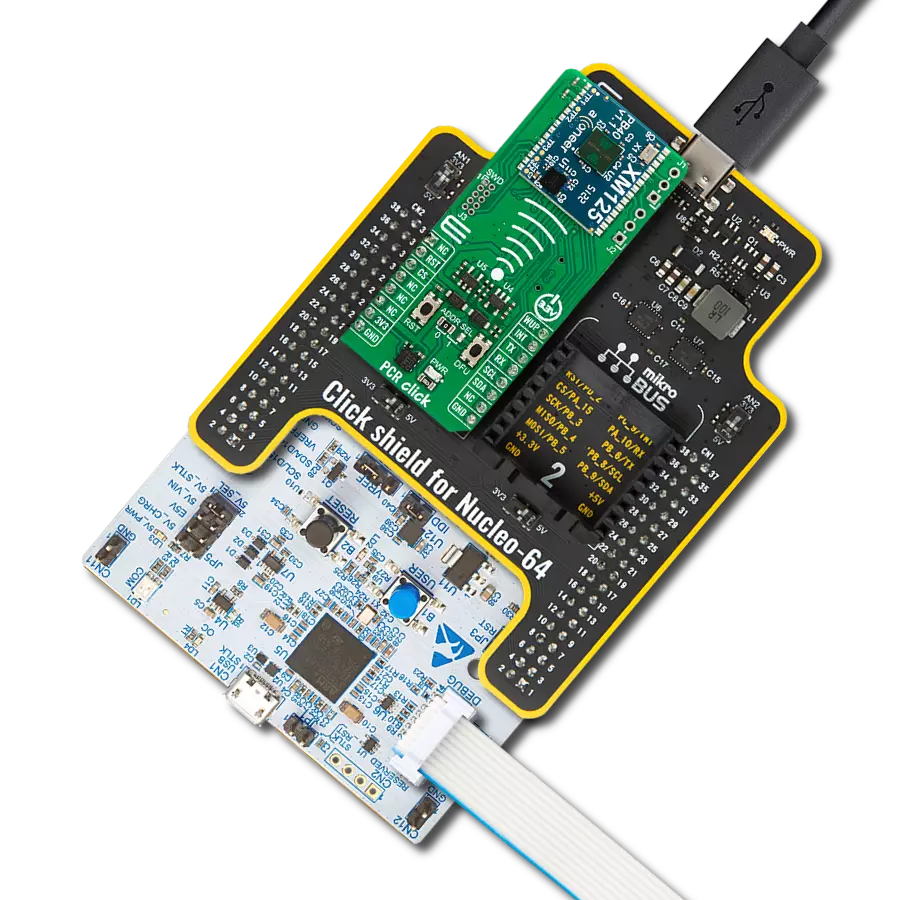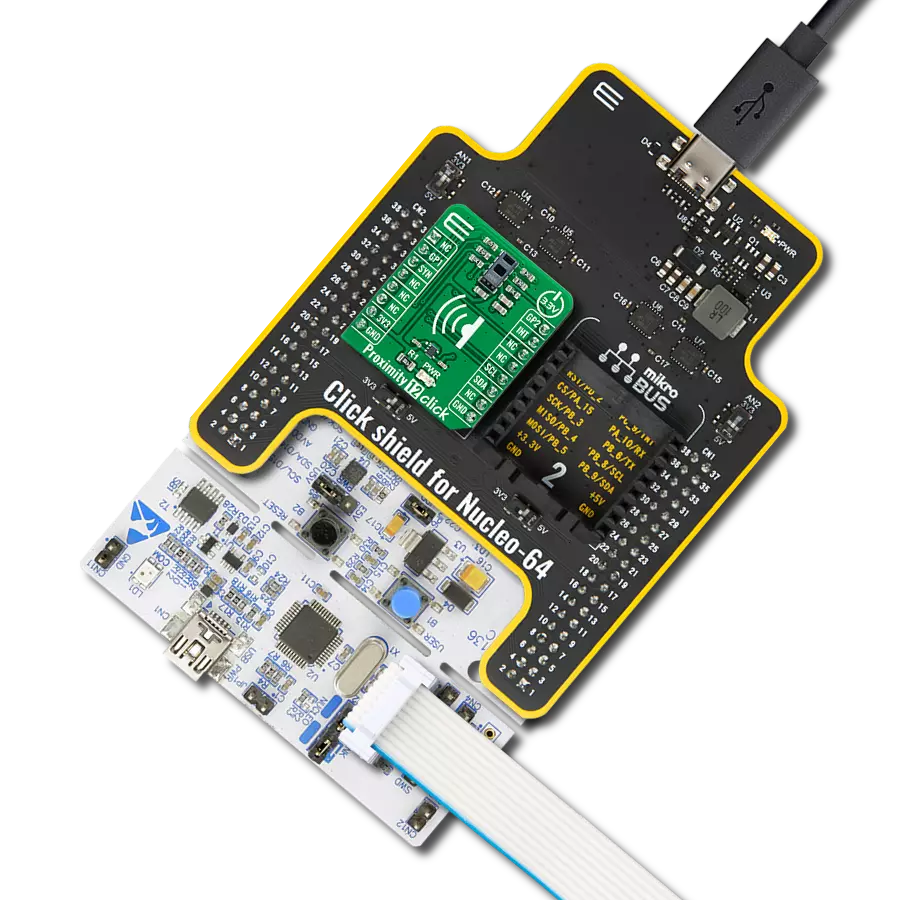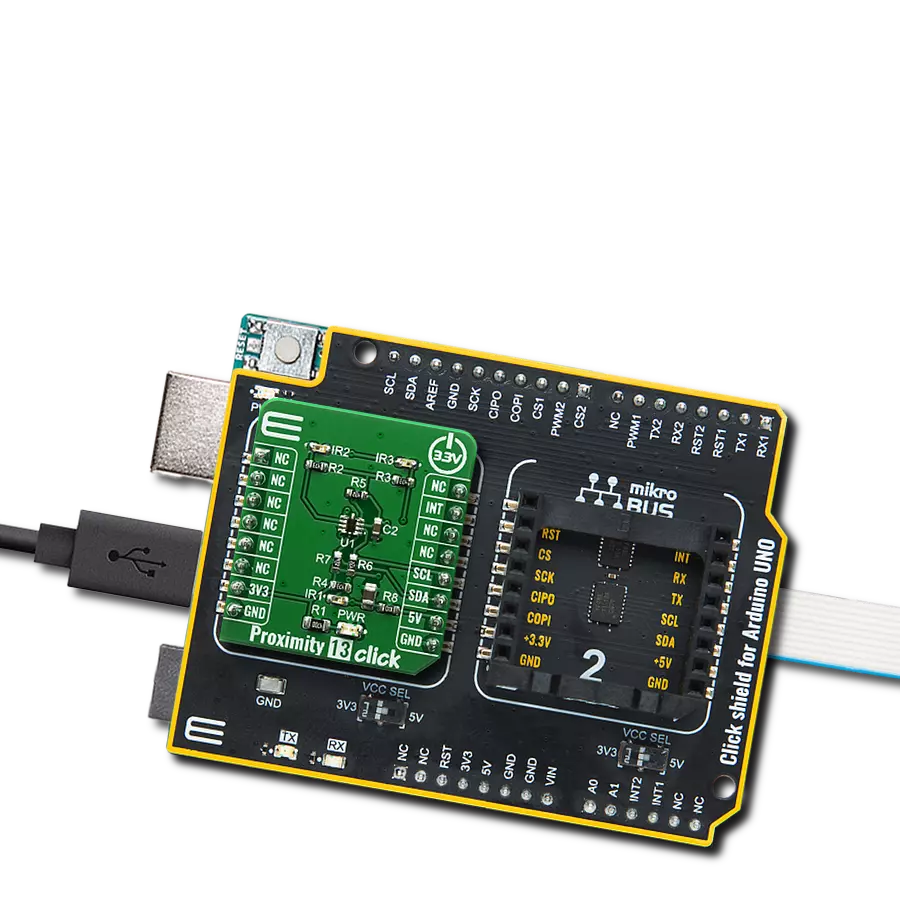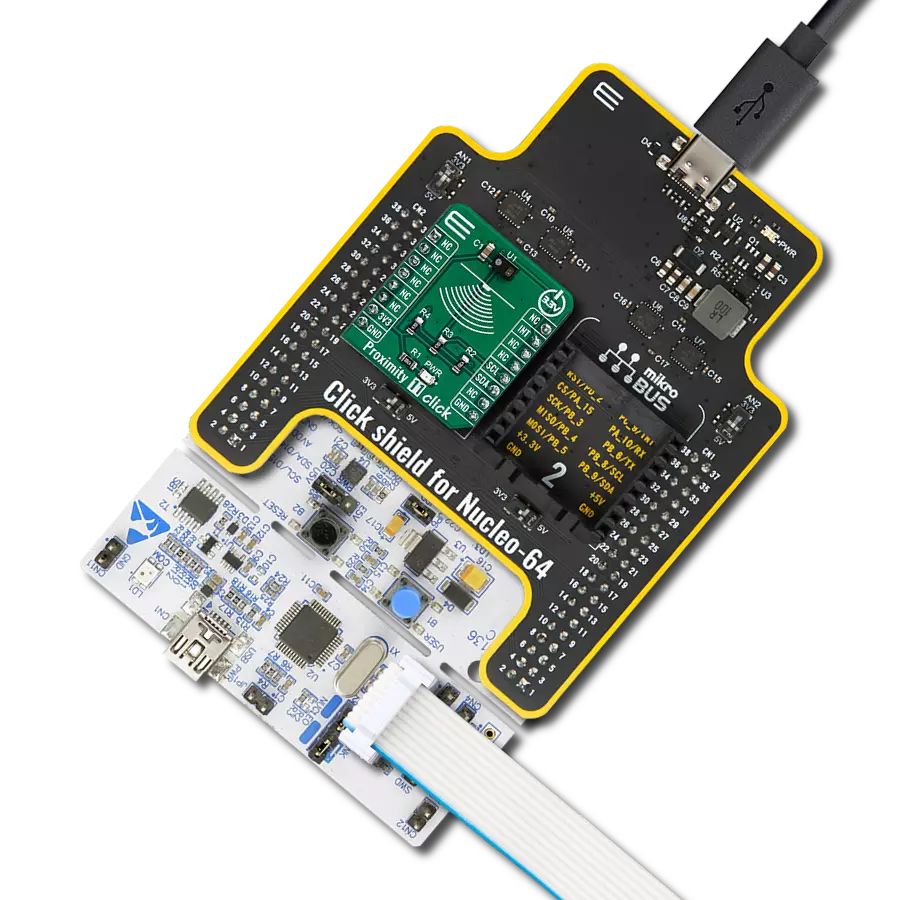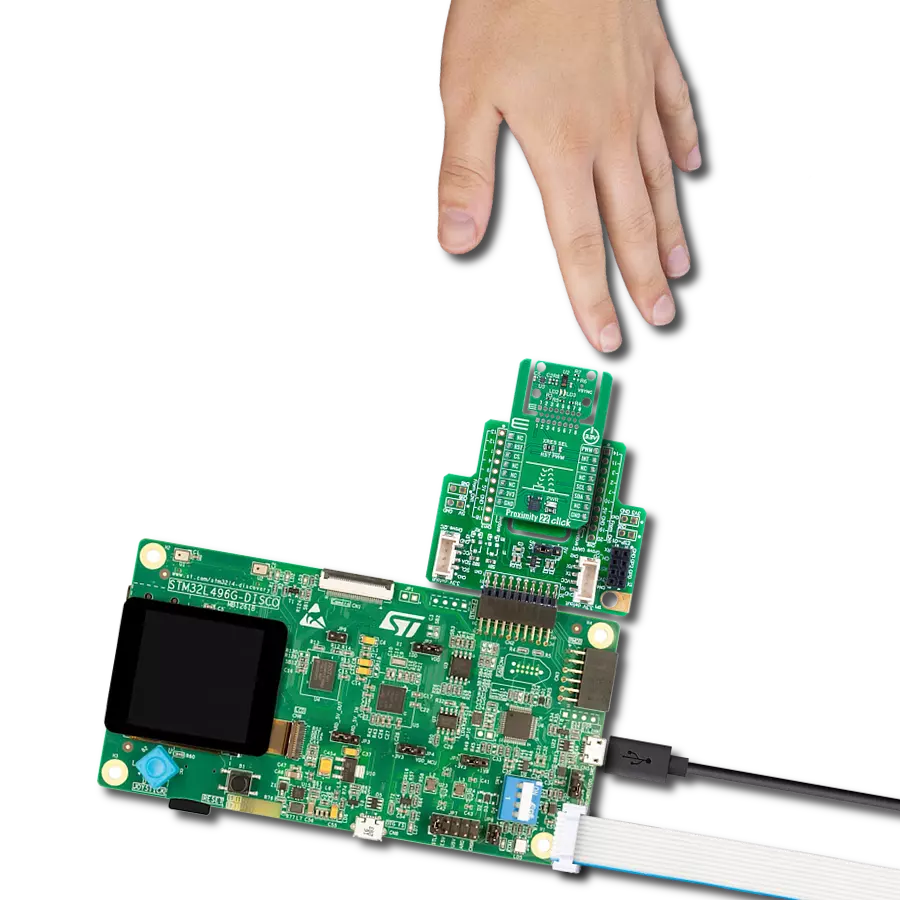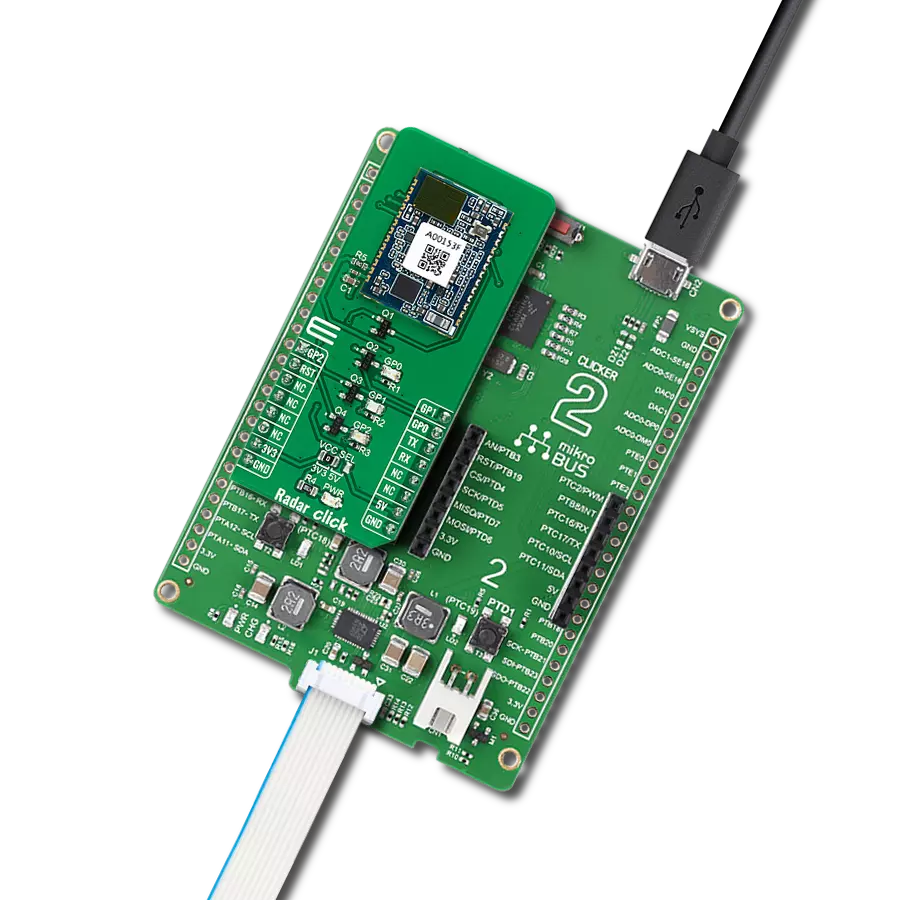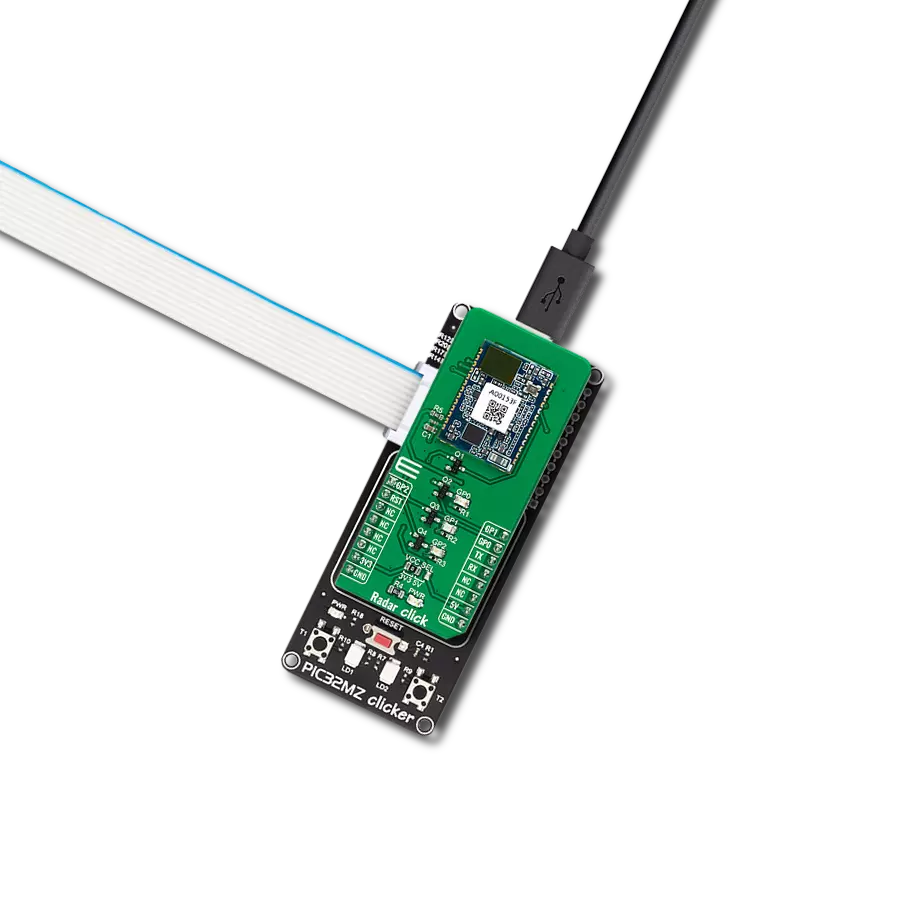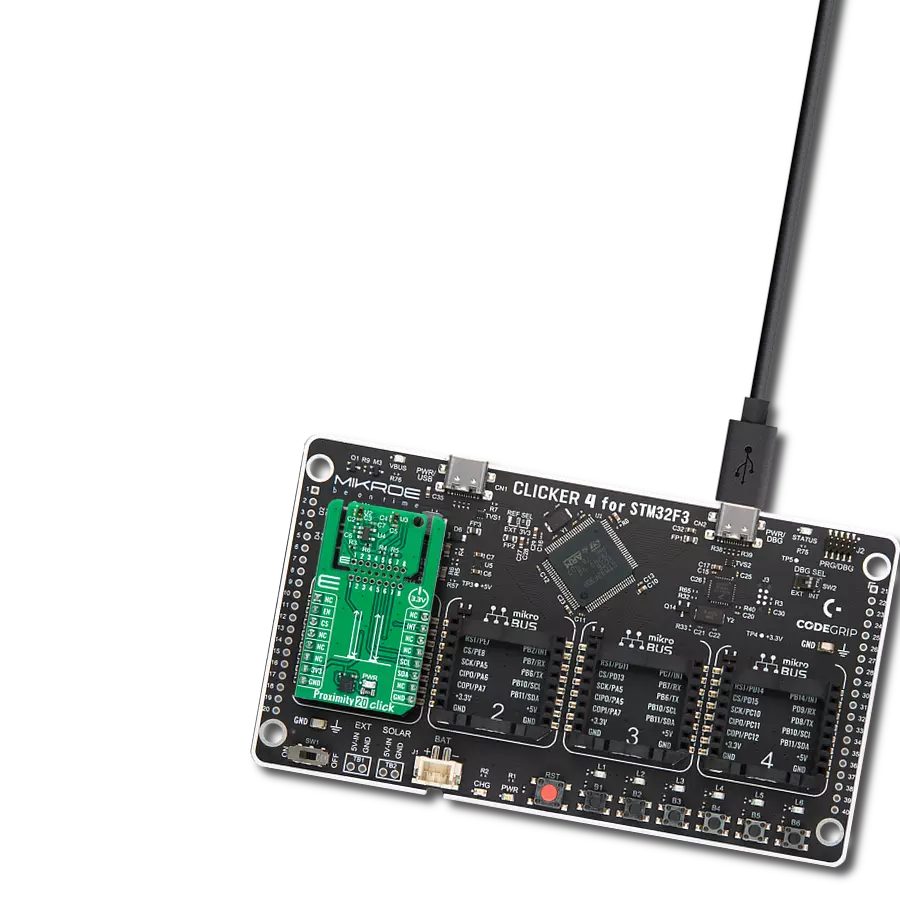Detect nearby objects without touching it
A
A
Hardware Overview
How does it work?
Proximity 18 Click is based on the VCNL3036X01, a close-range digital proximity sensor from Vishay Semiconductors. The VCNL3036X01 integrates a proximity sensor, a mux, and a driver for three external LEDs (green LED VLMTG1300 and dual-pack IR, and Red LED VSMD66694) located near the chip on the board, alongside photodiodes, amplifiers, and analog to digital conversion circuits into a single CMOS chip. Proximity 18 Click provides absolute distance measurement that is accurate up to 50cm. The VCNL3036X01 supports various basic proximity function settings such as duty ratio, integration time, interrupt, proximity enable, disable, and persistence, all handled by the register configurations. Besides Normal operation mode, it also simplifies the use of proximity detection mode that outputs
HIGH / LOW levels, saving loading from the host selected via register settings. Proximity 18 Click communicates with an MCU using the standard I2C 2-wire interface to read data and configure settings, supporting Fast Mode up to 400kHz. The command register controls all operations. The simple command structure helps users program the operation setting easily and latch the light data from VCNL3036X01. It is simple for the host MCU to access proximity output data via the I2C interface without extra software algorithms. A further benefit is that the VCNL3036X01 also provides a programmable interrupt feature of individual high and low thresholds, resulting in the best utilization of MCU resources and power routed to the INT pin on the mikroBUS™ socket. If the interrupt function is enabled, the host reads the proximity
output data from VCNL3036X01, which saves the host loading from periodically-read proximity data. More than that, an interrupt flag indicates the interrupt behavior triggered under different conditions. Once the host reads the result, the interrupt is cleared, and the ranging sequence can repeat. This Click board™ can operate with both 3.3V and 5V logic voltage levels. It should be highlighted that the VCNL3036X01 works exclusively at 3.3V, so it is necessary to perform appropriate logic voltage level conversion before using MCUs with different logic levels. 5V is used only for powering the LEDs. However, the Click board™ comes equipped with a library containing functions and an example code that can be used, as a reference, for further development.
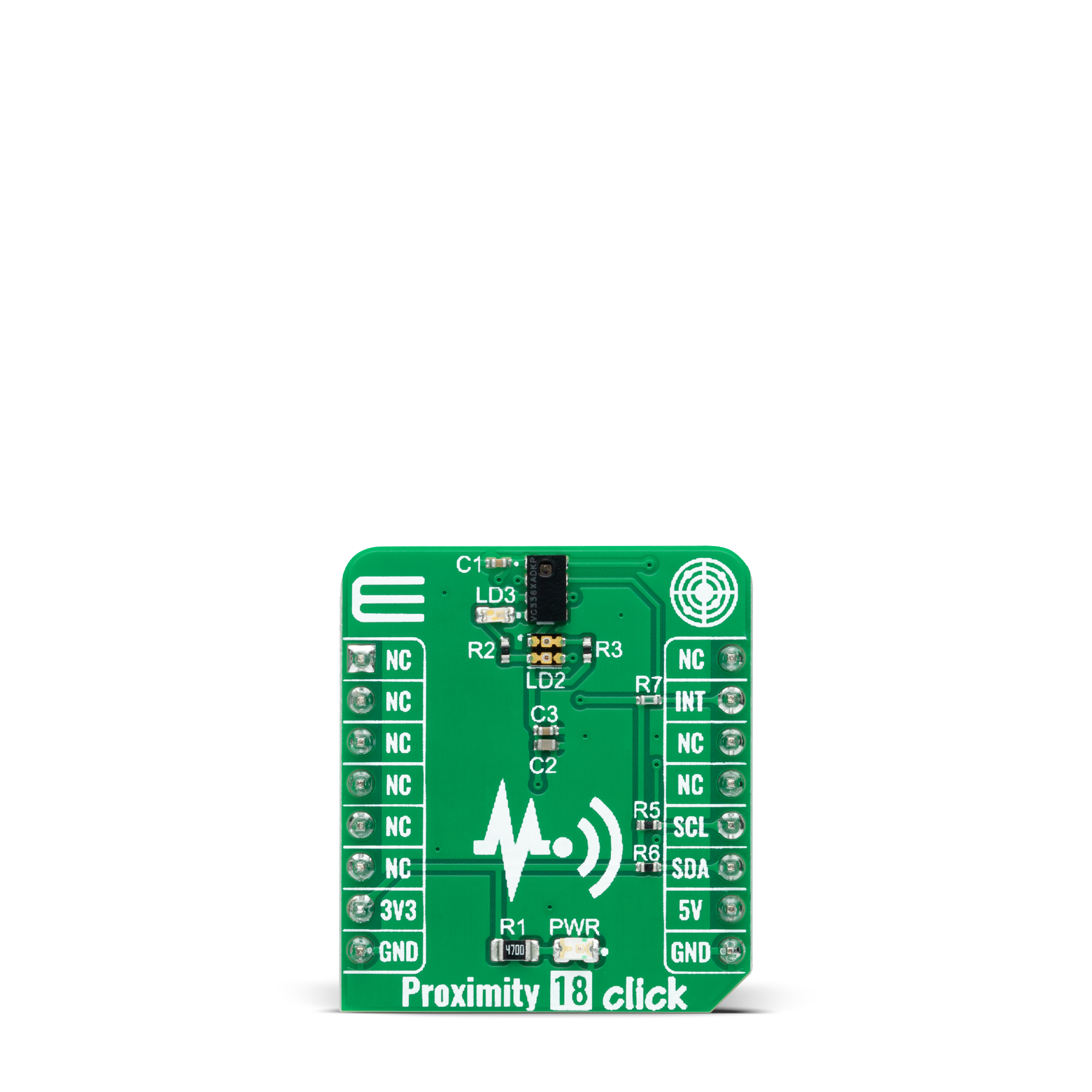
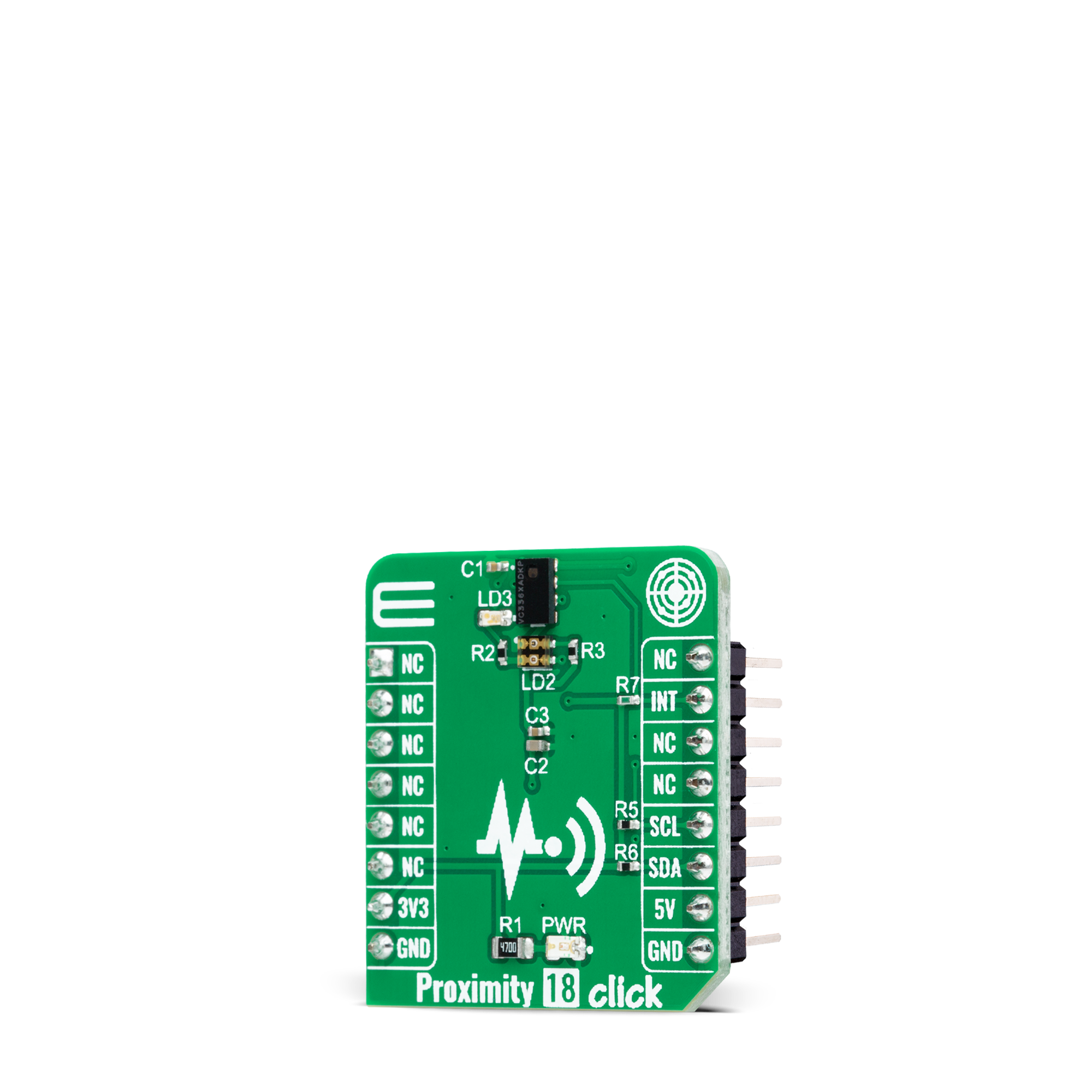
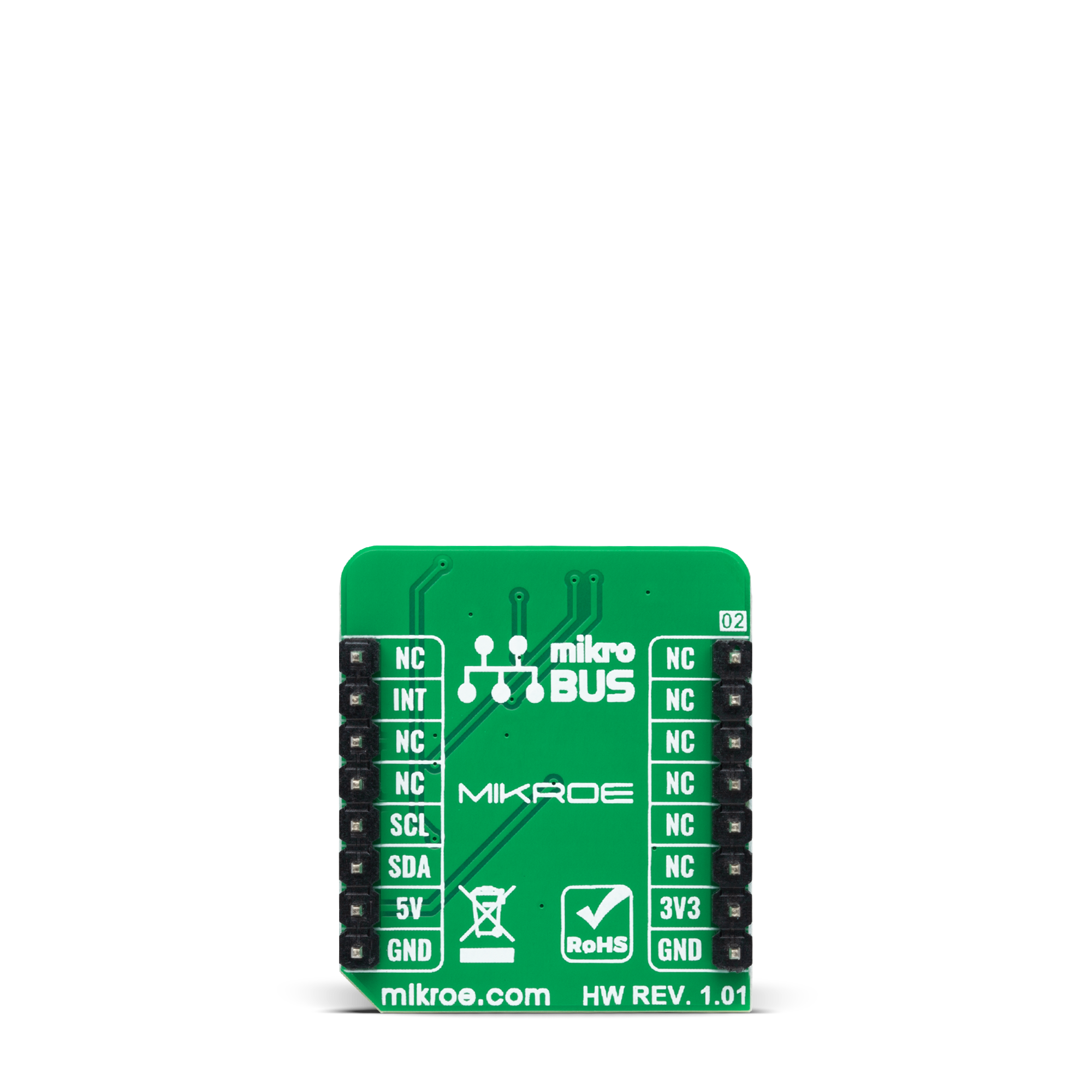
Features overview
Development board
Nucleo-64 with STM32F091RC MCU offers a cost-effective and adaptable platform for developers to explore new ideas and prototype their designs. This board harnesses the versatility of the STM32 microcontroller, enabling users to select the optimal balance of performance and power consumption for their projects. It accommodates the STM32 microcontroller in the LQFP64 package and includes essential components such as a user LED, which doubles as an ARDUINO® signal, alongside user and reset push-buttons, and a 32.768kHz crystal oscillator for precise timing operations. Designed with expansion and flexibility in mind, the Nucleo-64 board features an ARDUINO® Uno V3 expansion connector and ST morpho extension pin
headers, granting complete access to the STM32's I/Os for comprehensive project integration. Power supply options are adaptable, supporting ST-LINK USB VBUS or external power sources, ensuring adaptability in various development environments. The board also has an on-board ST-LINK debugger/programmer with USB re-enumeration capability, simplifying the programming and debugging process. Moreover, the board is designed to simplify advanced development with its external SMPS for efficient Vcore logic supply, support for USB Device full speed or USB SNK/UFP full speed, and built-in cryptographic features, enhancing both the power efficiency and security of projects. Additional connectivity is
provided through dedicated connectors for external SMPS experimentation, a USB connector for the ST-LINK, and a MIPI® debug connector, expanding the possibilities for hardware interfacing and experimentation. Developers will find extensive support through comprehensive free software libraries and examples, courtesy of the STM32Cube MCU Package. This, combined with compatibility with a wide array of Integrated Development Environments (IDEs), including IAR Embedded Workbench®, MDK-ARM, and STM32CubeIDE, ensures a smooth and efficient development experience, allowing users to fully leverage the capabilities of the Nucleo-64 board in their projects.
Microcontroller Overview
MCU Card / MCU
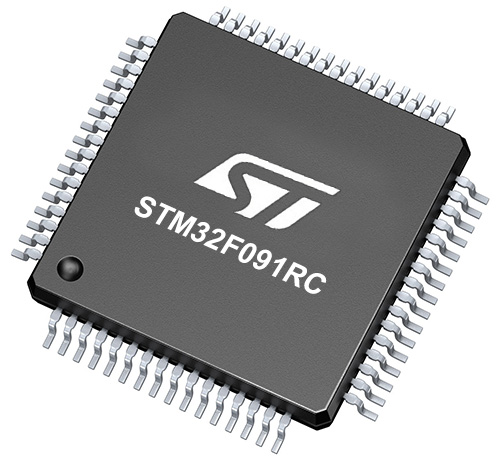
Architecture
ARM Cortex-M0
MCU Memory (KB)
256
Silicon Vendor
STMicroelectronics
Pin count
64
RAM (Bytes)
32768
You complete me!
Accessories
Click Shield for Nucleo-64 comes equipped with two proprietary mikroBUS™ sockets, allowing all the Click board™ devices to be interfaced with the STM32 Nucleo-64 board with no effort. This way, Mikroe allows its users to add any functionality from our ever-growing range of Click boards™, such as WiFi, GSM, GPS, Bluetooth, ZigBee, environmental sensors, LEDs, speech recognition, motor control, movement sensors, and many more. More than 1537 Click boards™, which can be stacked and integrated, are at your disposal. The STM32 Nucleo-64 boards are based on the microcontrollers in 64-pin packages, a 32-bit MCU with an ARM Cortex M4 processor operating at 84MHz, 512Kb Flash, and 96KB SRAM, divided into two regions where the top section represents the ST-Link/V2 debugger and programmer while the bottom section of the board is an actual development board. These boards are controlled and powered conveniently through a USB connection to program and efficiently debug the Nucleo-64 board out of the box, with an additional USB cable connected to the USB mini port on the board. Most of the STM32 microcontroller pins are brought to the IO pins on the left and right edge of the board, which are then connected to two existing mikroBUS™ sockets. This Click Shield also has several switches that perform functions such as selecting the logic levels of analog signals on mikroBUS™ sockets and selecting logic voltage levels of the mikroBUS™ sockets themselves. Besides, the user is offered the possibility of using any Click board™ with the help of existing bidirectional level-shifting voltage translators, regardless of whether the Click board™ operates at a 3.3V or 5V logic voltage level. Once you connect the STM32 Nucleo-64 board with our Click Shield for Nucleo-64, you can access hundreds of Click boards™, working with 3.3V or 5V logic voltage levels.
Used MCU Pins
mikroBUS™ mapper
Take a closer look
Click board™ Schematic

Step by step
Project assembly
Software Support
Library Description
This library contains API for Proximity 18 Click driver.
Key functions:
proximity18_start_measurementThis function starts the measurement by setting the one-time trigger bit in the PS_CONF3_MS register.proximity18_wait_for_data_readyThis function waits for the MPX data ready interrupt flag.proximity18_read_proximityThis function reads the proximity data from all three sensors.
Open Source
Code example
The complete application code and a ready-to-use project are available through the NECTO Studio Package Manager for direct installation in the NECTO Studio. The application code can also be found on the MIKROE GitHub account.
/*!
* @file main.c
* @brief Proximity 18 Click example
*
* # Description
* This example demonstrates the use of Proximity 18 Click board by reading and
* displaying the proximity data on the USB UART.
*
* The demo application is composed of two sections :
*
* ## Application Init
* Initializes the driver and logger, and performs the Click default configuration.
*
* ## Application Task
* Reads the proximity data from 3 sensors in a multiplex mode and displays it on the USB UART
* approximately once per second. The higher the proximity value, the closer the detected object is.
*
* @author Stefan Filipovic
*
*/
#include "board.h"
#include "log.h"
#include "proximity18.h"
static proximity18_t proximity18;
static log_t logger;
void application_init ( void )
{
log_cfg_t log_cfg; /**< Logger config object. */
proximity18_cfg_t proximity18_cfg; /**< Click config object. */
/**
* Logger initialization.
* Default baud rate: 115200
* Default log level: LOG_LEVEL_DEBUG
* @note If USB_UART_RX and USB_UART_TX
* are defined as HAL_PIN_NC, you will
* need to define them manually for log to work.
* See @b LOG_MAP_USB_UART macro definition for detailed explanation.
*/
LOG_MAP_USB_UART( log_cfg );
log_init( &logger, &log_cfg );
log_info( &logger, " Application Init " );
// Click initialization.
proximity18_cfg_setup( &proximity18_cfg );
PROXIMITY18_MAP_MIKROBUS( proximity18_cfg, MIKROBUS_1 );
if ( I2C_MASTER_ERROR == proximity18_init( &proximity18, &proximity18_cfg ) )
{
log_error( &logger, " Communication init." );
for ( ; ; );
}
if ( PROXIMITY18_ERROR == proximity18_default_cfg ( &proximity18 ) )
{
log_error( &logger, " Default configuration." );
for ( ; ; );
}
log_info( &logger, " Application Task " );
}
void application_task ( void )
{
uint16_t ps1_data, ps2_data, ps3_data;
if ( PROXIMITY18_ERROR == proximity18_start_measurement ( &proximity18 ) )
{
log_error ( &logger, " Start measurement." );
Delay_ms ( 1000 );
Delay_ms ( 1000 );
Delay_ms ( 1000 );
Delay_ms ( 1000 );
Delay_ms ( 1000 );
}
if ( PROXIMITY18_ERROR == proximity18_wait_for_data_ready ( &proximity18 ) )
{
log_error ( &logger, " Wait for data ready." );
Delay_ms ( 1000 );
Delay_ms ( 1000 );
Delay_ms ( 1000 );
Delay_ms ( 1000 );
Delay_ms ( 1000 );
}
if ( PROXIMITY18_ERROR == proximity18_read_proximity ( &proximity18, &ps1_data, &ps2_data, &ps3_data ) )
{
log_error ( &logger, " Read proximity." );
Delay_ms ( 1000 );
Delay_ms ( 1000 );
Delay_ms ( 1000 );
Delay_ms ( 1000 );
Delay_ms ( 1000 );
}
else
{
log_printf ( &logger, " PS1 data: %u\r\n", ps1_data );
log_printf ( &logger, " PS2 data: %u\r\n", ps2_data );
log_printf ( &logger, " PS3 data: %u\r\n\n", ps3_data );
}
Delay_ms ( 1000 );
}
int main ( void )
{
/* Do not remove this line or clock might not be set correctly. */
#ifdef PREINIT_SUPPORTED
preinit();
#endif
application_init( );
for ( ; ; )
{
application_task( );
}
return 0;
}
// ------------------------------------------------------------------------ END
Additional Support
Resources
Category:Proximity

















